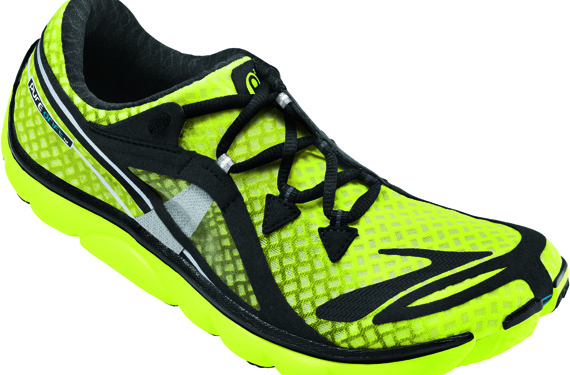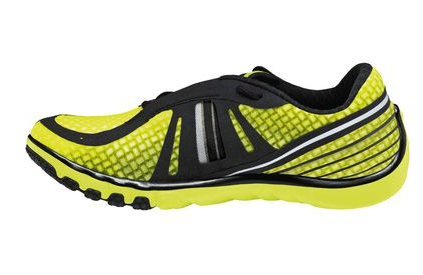Every shoe has a design rooted in something, whether purely an aesthetic or something as complicated as a pre-contrived shape based on biomechanical models of how a foot moves. The latter is more common, certainly. I caught up with Carson Caprara, footwear product line manager for Brooks, to discuss just how a new shoe—in this case, the PureDrift running shoe that is set to debut on Jan. 12—takes on a shape and a visually distinctive design. The PureDrift is a high-performance running shoe geared toward the minimalist and inspired by barefoot running. The design follows suit.
Brooks is touted as a highly technical brand, so entering the world of well-thought out design is, admittedly, a new arena for the Pacific Northwest-based company, but Caprara says they’ll engage in as much design quirkiness as possible along the way, even if it means learning more about shapes and colors.
Tim Newcomb: Does a project like this start from scratch or from the framework of another shoe?
Carson Caprara: The PureDrift, being brand new but the second version within a collection, did give us some design principles (to start from). There are certain technologies that as a collection every shoe needs to have. The initial framework was set, but there were a lot of things that we did have to start from scratch to give the PureDrift a unique position and to not cannibalize others in the line. From a design perspective, there was a push for flexibility, lightweight and getting closer to the ground.
How did those goals shape the start of the design?
Our true objective was to figure out how far to push lightweight and flexible while maintaining comfort. We felt like there was a boundary, going to a barefoot-type shoe can be uncomfortable. We were able to tweak little things to see how far we could go to get that experience, so we looked at the offset and created a customizable component to let the runner make the choice (between a 4 mm offset and a zero offset).
Did that drive the shape of the shoe visually?
It comes down to biomechanical insights. We get pretty geeky when it comes to that stuff. We are not good at drawing stuff that looks cool without functional insight. We have tried that and it didn’t work. We have a researcher in Germany and we went over there and had barefoot models and laid them over current shoes and drew different shapes that allowed the foot to create maximum flexibility and surface area with the ground. If you look, we have a narrow heel, fairly narrow instep and it widens out in the toebox. You spend the majority of your time (when running) in the forefoot and the magnitude of pressure is higher in the forefoot. The idea behind the oblong shape is to allow the pressure to disperse over the surface are and allow joints to fully articulate.
What comes next in the process after determining the shape?
The shape is the outline, the skeleton. From there, you have got to fill it in with the midsole, the foam. On the bottom there are two distinct grooves, one all the way through and one to the midfoot. It is all based on the anatomy of the foot. The big toe needs to separate and act independently as a lever and the second groove separates the fourth and fifth toes, which connect to the body different than the other toes. We mimicked the natural makeup of the foot so the foot could truly articulate in its natural manner. From there we spent a lot of time looking at raw materials being soft. There is no sewing or stitching on the upper. We used heat press that adheres overlays to the mesh with nice elasticity so all the contact areas are pretty soft.
Do you try to make all this biomechanics visually striking?
From 10 feet away, the Pure Project shoes need to be a collection, speaking the same language on a wall. From the 1-foot, 1-inch level, every Pure Project has a unique design to them, all with different routes and overlay takes. The Drift has an overlay that wraps around the side to speak to the simplicity of the design. We have an iconic rounded heel with foam that comes up and speaks to our unique geometry back there. The tip of the shoe has a distinct rift through the foam, which is a biomechanical insight. In the Pure Project we value simplicity and the body driving the run, so we want the shoe to get out of the way, so we use a lot of blocking patterns and are very tonal. We use the same color on different layers so it is simple and clean.
How can you stand out from the other shoe manufacturers?
Our point of view is so unique and cutting edge in the technologies that we are a little weird or a little quirky because of all the detail. They all have unique Brooksisms to them, the little details to them that we think about that other companies don’t potentially think about.
With a process taking months, how are colors decided?
You know those little Magic 8 balls that you shake up and they tell you things? We have five of those in the office. Seriously, though, color is complicated. Our brand has been so technology first and science first that we have thrown color on the end. But we want to get more modern and contemporary and diving into the color game can be eye opening. A color that looks good now may be stale by the time you get to market in six months. We are spending time in New York getting into higher fashion, trying to get nuggets to see the future. Instead of looking at colors that are available, we are driving vendors to create colors that will be on trend. It is the very end of the process because color does move faster and it’s tough. It’s a puzzle.






